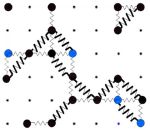EPJ B Highlight - A step closer to composite-based electronics
- Details
- Published on 19 November 2013

A new study demonstrates that electrical resistivity obeys a staircase-like dependence on the conducting particle concentration in composite materials
Composite materials are of increasing interest to physicists. Typically, they are made of electrically conducting elements - such as spherical metallic or elongated carbon particles - embedded in an insulating glass or a polymer matrix. Their controllable electrical resistivity combined with their light and flexible properties, makes them suited for applications in flexible electronics. Now, a theoretical model, confirmed experimentally, elucidates how electrical resistivity varies with the concentration of the particles in these composite materials. These findings have been published in EPJ B, by Isaac Balberg and colleagues from the Hebrew University in Jerusalem, Israel.
To understand the dependence of resistivity on the concentration of the electrically conducting particles, the authors apply percolation theory. It provides a map for the number and size of clusters of adjacent particles as the concentration of particles increases. In this study, the authors note that the resistances involved in the electrical conduction can have a given discrete series of values unlike a single one or a continuous distribution found in many previous works.
Balberg and colleagues made the theoretical prediction - and proved experimentally using granular metal and carbon-black composites - that the dependence of the electrical resistance on the conducting particle concentration is manifested by a staircase. This was particularly obvious in nanometric scale systems, in which there is a well-defined discrete series of distances between a particle and its neighbours. Each stair exhibits a universal behaviour - independent of the details of the system - predicted by percolation theory. The electrical resistivity associated with subsequent stairs decreases as the concentration of the conducting particles increases.
This work was also able to shed light on many previously unexplained data related to characteristics of various types of composites - such as those containing carbon nanotubes or graphene.
I. Balberg, D. Azulay, Y. Goldstein, J. Jedrzejewski, G. Ravid and E. Savir (2013), The percolation staircase model and its manifestation in composite materials, European Physical Journal B, DOI 10.1140/epjb/e2013-40200-7




